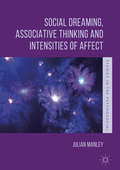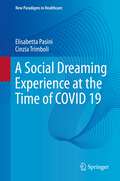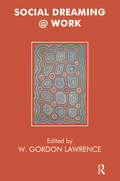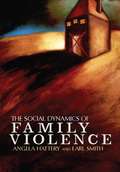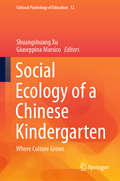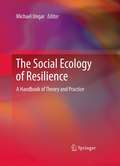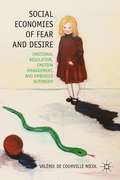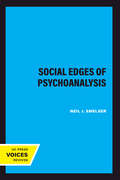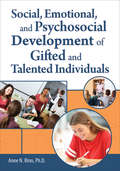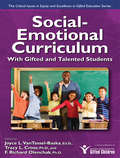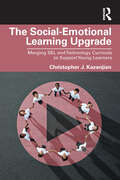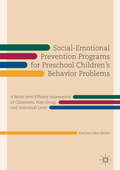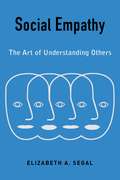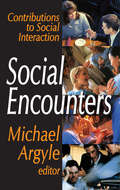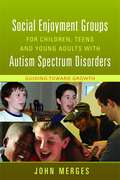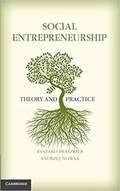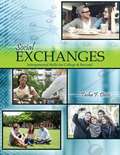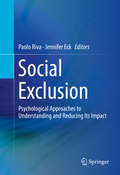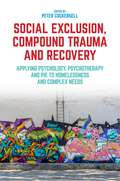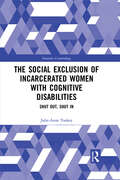- Table View
- List View
Social Dreaming, Associative Thinking and Intensities of Affect (Studies in the Psychosocial)
by Julian ManleyThis book describes a way of sharing dreams in a group, called ‘social dreaming’. It explores how the sharing of real, night time dreams, in a group, can offer information on and insight into ourselves and the worlds we live in and share. It investigates how we can turn dream images, and ideas and feelings that arise from these images, into conscious thought, before describing the ways in which these can be used. Using a background of the psychosocial combined with a philosophical lens influenced by the work of Gilles Deleuze, Julian Manley shows how social dreaming can be understood as a Deleuzian ‘rhizome of affects’, a web or a root design where things interconnect in a random and spontaneous fashion rather than in a sequential or linear way. He illustrates how social dreaming can link dreams together into a collage of images, and compares this to the rhizome, where clusters of emotional intensity – which emerge from the dream images – weave and interconnect with other clusters, forming a web of interlinked dream images and emotions. From the basis of this rhizome emerges an interpretation of social dreaming as a ‘body without organs’ and the social dreaming matrix as a ‘smooth space’ where meanings emerge from the way these images form connections, and come and go according to our emotions at any particular moment.
A Social Dreaming Experience at the Time of COVID 19 (New Paradigms in Healthcare)
by Elisabetta Pasini Cinzia TrimboliThe book describes the experience of four Social Dreaming Matrices held online between March and May 2020, during the first lockdown caused by the Covid 19 emergency. The pandemic isolated us and imposed prolonged contact with ourselves and our solitary thoughts. Against this backdrop, there was hope for change, a desire for a different kind of sociability and different forms of intimacy. On the basis of this evidence, our research supports the shift "from experiencing trauma to reacting to trauma", looking at a collective traumatic experience not only as something to be overcome but as an opportunity for a transformation that changes our mental schemes in relation to the external context. We have identified Social Dreaming as a privileged technique to overcome a collective traumatic experience, supporting its elaboration through collective feelings, new connections between intuition and rational thought, the discovery of community meanings. The authors's thesis is that the much-needed transition from 'magical thinking' to 'transformative thinking' takes place in a setting that is able to contain the anxieties of life's transitional phases, supporting the creation of new rituals and new social bonds and sustaining the passage from “me” to a “wider we”.
Social Dreaming in the 21st Century: The World We Are Losing
by John Clare Ali ZarbafiWe are running out of ideas in Western society. Faced with global warming, Third World devastation, nuclear proliferation and the threat posed by religious conflict, we need new ways of thinking. After the loss and carnage of the Twentieth Century there is prevailing mood of uncertainty and paranoia, yet at the same time a denial of tragedy, a salvation fantasy, an illusion that we will be saved. The decline in social solidarity, the fragmentation of communal values and a growing sense of 'I' as opposed to 'we', are all signs of an inversion of moral certitudes, a disconnection from reality. This book asks what methods do we have at our disposal to understand and reverse this breakdown of communication within and between communities.
Social Dreaming @ Work
by David Armstrong W. Gordon Lawrence"Social Dreaming" is the name given to a method of working with dreams that are shared and associated to within a gathering of people, coming together for this purpose. Its immediate origins date back to the early 1980s. At that time, Gordon Lawrence was on the scientific staff of the Tavistock Institute of Human Relations. He was a core member of the Institute's Group Relations Programme, within which he had developed a distinctive approach centring around the concept of "relatedness" — that is, the ways in which individual experience and behaviour reflects and is structured by conscious and unconscious constructs of the group or organization in the mind...
The Social Dynamics of Family Violence
by Angela Hattery Earl SmithHattery (sociology, George Mason U.) and Smith (sociology and American ethnic studies, Wake Forest U.) introduce sociology students to family violence in the US throughout the life cycle, with specific focus on its social character and institutional causes. They discuss physical and sexual child abuse, elder abuse, intimate partner violence, and violence in subgroups like gay and lesbian families and military families, and provide theoretical frameworks and methods used to study it. They address the role of social institutions and structures like the economy and religion and explore variations across family groups, including differences in race and ethnicity, social class, and sexuality, and prevention and avoidance strategies, and criminal justice, social service, and legal responses. Annotation ©2012 Book News, Inc. , Portland, OR (booknews.com)
The Social Dynamics of Family Violence
by Angela Hattery Earl SmithThis compelling new text explores family violence throughout the life course, with special attention to the social character and institutional causes of family violence. From child abuse and neglect to intimate partner violence and elder abuse, Hattery and Smith ask students to consider how social inequality, especially gender inequality, contributes to tensions and explosive tendencies in family settings. Students learn about individual preventative measures and are also invited to question the justice of our current social structure, with implications for social policy and reorganization. Hattery and Smith pepper the text with evocative case studies from their own research and illuminating stories published in mainstream media. Unique coverage of same-sex couples and multicultural couples, as well as of theory and methods, make this text an essential element of any course considering the sociology of family violence.
Social Ecology of a Chinese Kindergarten: Where culture grows (Cultural Psychology of Education #12)
by Shuangshuang Xu Giuseppina MarsicoThis book is the outcome of a joint collaboration between East China Normal University and the University of Luxembourg, initiated by the Center of Ideas for the Basic Education of the Future (IBEF), and focuses on kindergartens in China from a cultural psychology perspective. By coupling young scholars from diverse cultural backgrounds as research tandems, this book uses an innovative methodological method to reveal a deeply immersing research perspective of the often complicated issues in the Chinese social reality, where long historical tradition and strong motivation for a “modernized” future are fused together and continuously evolve itself into a vibrant and intricate landscape. Meanings and values consciously or unconsciously promoted and conducted in the kindergarten are semiotic devices and they mediate children’s and educator’s daily behaviours and activities, which are constantly navigating among different social institutions and crossing the border of kindergarten. The book discusses the process of children’s socialization in the kindergarten from different angles such as cultural objects, moral education, conflict negotiation, children's drawing analysis and the role of Lego in numeracy development. It also provides an overview of basic educational needs in Chinese kindergartens as well as three commentaries to provide background information and to add a reflective angle for the readers. By reading the book, readers will hopefully go through a constantly transforming process between familiarizing and de-familiarizing along with the research tandem and develop their own understanding of the complex landscape of the Chinese kindergarten and its children as developing subjects constantly living and transcending the context.
The Social Ecology of Resilience
by Michael UngarMore than two decades after Michael Rutter (1987) published his summary of protective processes associated with resilience, researchers continue to report definitional ambiguity in how to define and operationalize positive development under adversity. The problem has been partially the result of a dominant view of resilience as something individuals have, rather than as a process that families, schools,communities and governments facilitate. Because resilience is related to the presence of social risk factors, there is a need for an ecological interpretation of the construct that acknowledges the importance of people's interactions with their environments. The Social Ecology of Resilience provides evidence for this ecological understanding of resilience in ways that help to resolve both definition and measurement problems.
Social Economies of Fear and Desire: Emotional Regulation, Emotion Management, and Embodied Autonomy
by Valérie de Courville NicolAll behaviours, indeed all forms of agency, are viewed as emotionally-driven. This book provides an approach to emotional experience and agency which drastically nuances the commonly held view that fear has predominantly irrational, morally, or ideologically suspect effects which thwart the exercise of autonomy.
The Social Edges of Psychoanalysis
by Neil J. SmelserFor several decades the writings of sociologist Neil J. Smelser have won him a vast and admiring audience across several disciplines. Best known for his work on social movements, economic sociology, and British social history, Smelser's psychoanalytic writings are less familiar to his readers. In fact, many people are completely unaware of Smelser's formal psychoanalytic training and ongoing counseling practice. With the publication of The Social Edges of Psychoanalysis, Smelser's thought-provoking essays on psychoanalytic concepts are finally brought together in one book.Psychoanalytic theory has had an ambivalent relationship with sociology, and these essays explore that ambivalence, providing arguments about how and why psychoanalytic approaches can deepen the sociological perspective. One of Smelser's main tenets is that human social behavior always contains both social-structural and social-psychological elements, and that psychoanalytic theory can bridge these two dimensions of human social life. Many of the issues Smelser addresses—including interdisciplinarity, the macro-micro link in research, masculinity and violence, and affirmative action—have generated considerable scholarly interest.This collection paves the way for further articulation of the relationship between sociology and psychoanalysis at a time when many sociologists are looking for interdisciplinary links in their work. Presented with clarity and grace, and free of the murkiness often found in both sociological and psychoanalytic writing, Smelser's new book will excite reflection and research on the less visible dynamics of social existence.
Social, Emotional, and Behavioral Supports in Schools: Linking Assessment to Tier 2 Intervention (The Guilford Practical Intervention in the Schools Series)
by Sara C. McDaniel Allison L. Bruhn Sara EstrapalaMeeting a critical need, this accessible guide addresses the "whats," "whys," and "how-tos" of developing and implementing effective Tier 2 social, emotional, and behavioral supports. The book provides explicit steps for identifying K–12 students who could benefit from Tier 2, matching evidence-based interventions to student needs, and making individualized, data-based decisions regarding adapting, fading, or intensifying supports. Chapters review exemplary interventions in the areas of conduct, self-regulation, social issues, emotional issues, and co-occurring academic and social–emotional–behavioral needs. The place of Tier 2 in schoolwide positive behavioral interventions and supports (PBIS) is explained, and keys to implementation fidelity are highlighted. In a large-size format for easy photocopying, the book includes 23 reproducible forms and checklists that can also be downloaded and printed. This book is in The Guilford Practical Intervention in the Schools Series, edited by Sandra M. Chafouleas.
Social, Emotional, and Psychosocial Development of Gifted and Talented Individuals
by Anne RinnSocial, Emotional, and Psychosocial Development of Gifted and Talented Individuals:Merges the fields of individual differences, developmental psychology, and educational psychology with the field of gifted education.Provides a complete overview of the social, emotional, and psychosocial development of gifted and talented individuals.Explores multiple paradigmatic lenses and varying conceptions of giftedness.Serves as a comprehensive resource for graduate students, early career scholars, and teachers.Addresses implications for the field of gifted education and future research.This book is framed around four broad questions: (a) What is development?, (b) Are gifted individuals qualitatively different from others?, (c) Which psychosocial skills are necessary in the development of talent?, and (d) What effect does the environment have on the development of talent? Topics covered include developmental trajectories, personality development, social and emotional development, perfectionism, sensory sensitivity, emotional intensity, self-beliefs, motivation, systems perspective, psychosocial interventions, and counseling and mental health.
The Social Emotional Classroom: A New Way to Nurture Students and Understand the Brain
by Anna-Lisa Mackey Melissa RaganLearn to implement powerful new learning techniques in your classroom experience In The Social Emotional Classroom, celebrated educators and authors Anna-Lisa Mackey and Melissa Ragan deliver an insightful, rigorous, and accessible treatment of social emotional learning in education. Using research from the Theory of Constructed Emotion, the authors highlight the relationship between the new view of neurobiology and Social Emotional Learning. The book connects five key competencies, including self-awareness, social awareness, self-management, responsible decision-making, and relationship skills, to this new understanding of the brain. You'll also learn from: Teacher stories included in each chapter The inclusion of over two decades worth of experience and research in the field of social and emotional learning Instructions and guides for educators to embed social and emotional learning into their everyday practices Perfect for K-12 educators, principals, superintendents, and other education leaders, The Social Emotional Classroom will also earn a place in the libraries of parents and caregivers who are responsible for young people's day-to-day learning.
Social-Emotional Curriculum With Gifted and Talented Students
by Joyce L. VanTessel-Baska Tracy L. CrossSocial-Emotional Curriculum With Gifted and Talented Students provides a thorough introduction to methods for developing social-emotional curricula for use with gifted and talented learners in the school setting. Educational Resource
The Social-Emotional Learning Upgrade: Merging SEL and Technology Curricula to Support Young Learners
by Christopher J. KazanjianThe Social-Emotional Learning Upgrade explores how today’s educators can connect two previously separated but important curricula in their schools: social-emotional learning (SEL) and educational technology. With schools’ SEL efforts pressed for time and resources and digital engagements often limited to skill development, K-12 students risk being unprepared to sustain their well-being and personal opportunities in a rapidly changing, technology-dependent world. Driven by a paradigm that synthesizes multicultural education and humanistic psychology, this book readies educators to implement SEL curricula that will support young learners as they navigate constant social and technological flux and that will nurture their unique perceptions of reality, their aspirations, and their mental and physical health. Each chapter’s novel insights will help to mitigate both student disengagement and teacher demoralization, enabling classroom pedagogies and the process of schooling to better align with the ways in which learners explore, express, and create meaning. Guiding pre-service teachers, leaders, and curriculum developers beyond common goals such as digital skills development, content mastery, or standardized testing, this volume focuses instead on complex digital literacies, collaborative experiences, problem- and project-based learning, culturally relevant pedagogies, and overall holistic growth.
Social-Emotional Prevention Programs for Preschool Children's Behavior Problems
by Catrinel Alice ŞtefanThis book is aimed at exploring the relevance of social-emotional competencies for preventing preschool children’s behavior problems. The content provides an overview of how evidence from fundamental research on social-emotional competencies can be translated in applied research for developing prevention programs. The Social-Emotional Prevention program framework is presented as a multi-focused (child, teacher, parent), hybrid approach for both high risk and non-risk preschoolers. The book offers a systematic and in depth evaluation of SEP efficacy including classroom, risk group, and individual level effects. Hence, the proposed approach employs different research designs and statistical methods to explore how behavioral changes occur as a result of children’s participation to the intervention. Each study’s findings are discussed in terms of corresponding implications for practice in schools, but also from a broader perspective including implications for policy makers in the field of early education.
Social Empathy: The Art of Understanding Others
by Elizabeth SegalOur ability to understand others and help others understand us is essential to our individual and collective well-being. Yet there are many barriers that keep us from walking in the shoes of others: fear, skepticism, and power structures that separate us from those outside our narrow groups. To progress in a multicultural world and ensure our common good, we need to overcome these obstacles. Our best hope can be found in the skill of empathy.In Social Empathy, Elizabeth A. Segal explains how we can develop our ability to understand one another and have compassion toward different social groups. When we are socially empathic, we not only imagine what it is like to be another person, but we consider their social, economic, and political circumstances and what shaped them. Segal explains the evolutionary and learned components of interpersonal and social empathy, including neurobiological factors and the role of social structures. Ultimately, empathy is not only a part of interpersonal relations: it is fundamental to interactions between different social groups and can be a way to bridge diverse people and communities. A clear and useful explanation of an often misunderstood concept, Social Empathy brings together sociology, psychology, social work, and cognitive neuroscience to illustrate how to become better advocates for justice.
Social Encounters: Contributions to Social Interaction
by Michael ArgyleSocial Encounters is an approach to social psychology that is not what one might expect to find in textbooks on this subject. As a companion to Social Interaction advocated by Michael Argyle and his associates, it has been used by a rapidly growing number of researchers in social psychology, and related aspects of ethology, anthropology, and linguistics. The two key ideas are to study the detailed processes of social interaction at the level of the elements of interaction, and to relate social behavior to its biological basis and cultural setting.This work collects excellent representative studies of different aspects of social interaction; as such they are important in their own right. Within the general approach described, a range of different academic orientations are included. All selections report empirical findings, and most of them introduce conceptual notions as well. One achievement of the volume has been to establish the basic elements of which social interaction consists; current research is concerned with finding out precisely how these elements function.The contributors agree that the field consists of various signals: verbal and non-verbal, tactile, visible and audible, bodily contact, proximity, orientation, bodily posture, physical appearance, facial expression, movements of head and hands, direction of gaze, timing of speech, emotional tone of speech, speech errors, type of utterance and linguistic structure of utterance. These elements can be further analyzed and divided into categories or dimensions; each plays a distinctive role in social interaction. Social behavior is studied in natural settings or replicas of natural settings, for which there are cultural rules familiar to the subjects. This is a pioneering statement in sociobiology.
Social Enjoyment Groups for Children, Teens and Young Adults with Autism Spectrum Disorders
by John MergesYoung people with autism spectrum disorders (ASD) often feel uncomfortable and anxious in social situations, but socializing with classmates and colleagues can be made easier - and more enjoyable - with Guiding Toward Growth group sessions. John Merges' simple yet effective program for teaching social enjoyment skills is based on the concept that there are ten hurdles that make it challenging for people with ASD to enjoy social interaction. This book guides the reader through planning, running, and assessing group sessions that have been designed to help participants overcome these hurdles, interact with confidence, and ultimately enjoy more independent and fulfilling lives. As social interaction is a vital element of any work environment, this book also teaches young adults with ASD an important employment skill. This adaptable book can be used with a wide range of ages and communicative abilities, and will be an invaluable resource for all professionals working with groups of children and young people with ASD.
Social Entrepreneurship: Theory and Practice
by Ryszard Praszkier Andrzej NowakSocial Entrepreneurship: Theory and Practice is about the creative ways in which social entrepreneurs solve pressing and insurmountable social problems. Theories of social change are presented to help demystify the 'magic' of making an immense, yet durable and irreversible, social impact. Utilizing case studies drawn from various fields and all over the world, the authors document how social entrepreneurs foster bottom-up change that empowers people and societies. They also review the specific personality traits of social entrepreneurs and introduce the new kind of leadership they represent. This book will be valuable to undergraduate, graduate and postgraduate students, while remaining accessible to non-academic readers thanks to its clear language, illustrative case studies and guidelines on how to become a successful social entrepreneur.
Social Exchanges: Interpersonal Skills For College And Beyond
by Tasha F. DavisSocial Exchanges: Interpersonal Skills For College And Beyond by Tasha F. Davis
Social Exclusion
by Jennifer Eck Paolo RivaFrom ostracism on the playground to romantic rejection, bullying at work, and social disregard for the aged, individuals are at constant risk of experiencing instances of social exclusion, including ostracism, rejection, dehumanization, and discrimination. These phenomena have a powerful impact as testified by their immediate influence on people's thoughts, emotions, and behaviors. Social Exclusion: Psychological Approaches to Understanding and Reducing Its Impact investigates different psychological approaches, across multiple psychological subdisciplines, to understanding the causes and consequences of social exclusion and possible ways to reduce or buffer against its negative effects. The purpose of this volume is threefold. First, it lays the groundwork for the understanding of social exclusion research; reviewing the different instances of social exclusion in everyday life and methods to experimentally investigate them. Second, this volume brings together different psychological approaches to the topic of social exclusion. Leading scholars from around the world contribute perspectives from social psychology, social neuroscience, developmental psychology, educational psychology, work and organizational psychology, clinical psychology, and social gerontology to provide a comprehensive overview of social exclusion research in different psychological subdisciplines. Taken together, these chapters are conducive to the important development of new and more integrative research models on social exclusion. Finally, this volume discusses psychological strategies such as emotion regulation, psychological resources, and brain mechanisms that can reduce or buffer against the negative consequences of social exclusion. From school shootings to domestic violence, from cognitive impairment to suicide attempts, the negative impact of social exclusion has been widely documented. Thus, from an applied perspective, knowing potential ways to mitigate the negative effects of social exclusion can have a significant positive influence on people's--and society's--well-being. Overall, this book provides the reader with the knowledge to understand the impact of social exclusion and with tools to address it across many different contexts. Importantly, Social Exclusion: Psychological Approaches to Understanding and Reducing Its Impact aims to bridge the gap between the approaches of different psychological subdisciplines to this topic, working towards a comprehensive, integrative model of social exclusion.
Social Exclusion, Compound Trauma and Recovery: Applying Psychology, Psychotherapy And Pie To Homelessness And Complex Needs
by Peter Cockersell John Connolly Nicola Saunders Dr Emma Williamson Catriona Reid Dr Sally Read Terry HuttonResponding to the growing number of psychologically-informed services for people experiencing social exclusion and, in particular, homelessness, this book gives professionals the information and understanding they need to be fully informed in their practice with this client group. It begins with theory, looking at the psychology of social exclusion and the processes that underlie it, and considers the relationship between trauma, complex needs, homelessness and social exclusion. Presenting practical interventions and case studies, the authors then reveal what makes an effective service in practice and a client perspective on social exclusion and recovery is provided. This is essential reading for all those involved in developing services that meet the needs of socially excluded people with histories of complex trauma or presentations of complex needs, including those who are homeless, refugees and asylum seekers, Traveller and Roma communities and people involved with the criminal justice system.
Social Exclusion in Later Life: Interdisciplinary and Policy Perspectives (International Perspectives on Aging #28)
by Kieran Walsh Thomas Scharf Sofie Van Regenmortel Anna WankaDrawing on interdisciplinary, cross-national perspectives, this open access book contributes to the development of a coherent scientific discourse on social exclusion of older people. The book considers five domains of exclusion (services; economic; social relations; civic and socio-cultural; and community and spatial domains), with three chapters dedicated to analysing different dimensions of each exclusion domain. The book also examines the interrelationships between different forms of exclusion, and how outcomes and processes of different kinds of exclusion can be related to one another. In doing so, major cross-cutting themes, such as rights and identity, inclusive service infrastructures, and displacement of marginalised older adult groups, are considered. Finally, in a series of chapters written by international policy stakeholders and policy researchers, the book analyses key policies relevant to social exclusion and older people, including debates linked to sustainable development, EU policy and social rights, welfare and pensions systems, and planning and development. The book’s approach helps to illuminate the comprehensive multidimensionality of social exclusion, and provides insight into the relative nature of disadvantage in later life. With 77 contributors working across 28 nations, the book presents a forward-looking research agenda for social exclusion amongst older people, and will be an important resource for students, researchers and policy stakeholders working on ageing.
The Social Exclusion of Incarcerated Women with Cognitive Disabilities: Shut Out, Shut In (Feminist Criminology)
by Julie-Anne TooheyThe Social Exclusion of Incarcerated Women with Cognitive Disabilities explores the lived experience of cognitively disabled women incarcerated in Australia. It draws upon in-depth interviews with Indigenous and non-Indigenous women, as well as interviews conducted with prison practitioners – psychologists, counsellors, and Aboriginal Liaison Officers. Using a theoretical framework of social exclusion, the book charts the complex intersection between cognitively disabled women and the Criminal Justice System, and how this connection works to foster and maintain a state of social exclusion prior to incarceration, and equally, within the prison setting. The book also provides a practical template for other researchers to use when investigating the aligned fields of the Criminal Justice System and incarceration, women offenders, cognitive disability, and social exclusion. By placing the voices of the incarcerated women with cognitive disabilities ‘front and centre’, a new and innovative approach to social exclusion emerges. The book moves beyond the 'telling of sad stories' to examine the social and political climate that permits disadvantage, inequality, and injustice to flourish. This book will be of great interest to academics and students in criminology, criminal justice, disability studies, women’s and gender studies, and penology. In exploring theory in a practical way, it will also be of use to those involved in the health sector, community services, disability support agencies, disability advocates, prisoner advocacy, women’s studies and women’s advocacy, and human rights activism.
